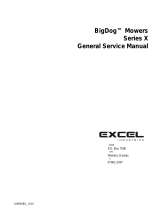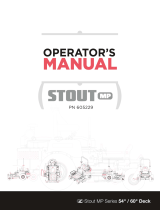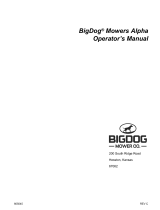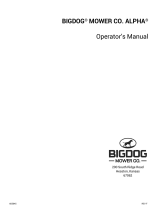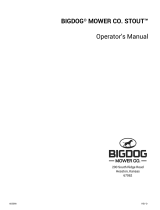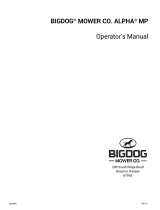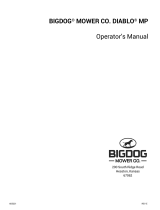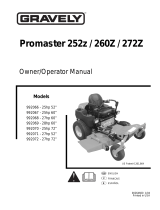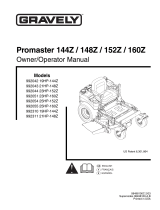
REV A 2-2 120123
to uncomfortable or loud noises can cause impairment
or loss of hearing.
• Do not wear radios or music headphones while operat-
ing the machinery. Safe operation requires your full
attention.
Operation Precautions
Avoid Fire Hazards
Clean flammable material from machine. Prevent
fires by keeping engine compartment, top of deck,
exhaust area, battery, hydraulic lines, fuel line, fuel
tank and operator’s station clean of accumulated
trash, grass clippings, and other debris. Always clean
up spilled fuel and oil.
Start Engine Safely
Avoid possible injury or death from machine runaway.
Do not start engine by shorting across starter terminals.
Before you start the engine:
• Sit on the operator’s seat.
• Move control levers to the neutral/brake position.
Operate Machine Safely
Refer to the unit’s operator’s manual for complete safety
information on safe machine operation.
Always maintain a safe distance from people and pets
when mowing
Always be aware of what is behind the machine before
backing up.
Never leave machine unattended with ignition key in
switch, especially with children present.
Follow daily and weekly checklists, making sure hoses
are tightly secured and bolts are tightened.
Always keep engine and machine clean, removing accu-
mulated dirt, trash and other material from machine.
Never put hands or feet under any part of the machine
while it is running.
Never attempt to start engine when there is a strong odor
of gasoline fumes present. Locate and correct cause.
Keep all safety shields and covers in place, except for
servicing.
Do not touch hot parts of machine.
General Maintenance Precautions
Repairs or maintenance requiring engine power
should be performed by trained maintenance person-
nel only.
Never run the engine in an enclosed area unless exhaust
is vented to the outside. Exhaust gases contain carbon
monoxide which is an odorless and deadly poison.
Unless specifically required, DO NOT have engine run-
ning when servicing or making adjustments to mower.
Park the machine on level ground. Place steering control
levers in the park brake position, disengage deck clutch,
lower deck, remove ignition switch key and disconnect
negative battery cable before doing any maintenance.
Wait for all movement to stop before adjusting, cleaning
or repairing. To prevent carbon monoxide poisoning, be
sure proper ventilation is available when engine must be
operated in an enclosed area.
Before working on or under the deck, make certain
engine cannot be accidentally started. Shut engine off,
remove ignition switch key and disconnect negative bat-
tery cable for maximum safety.
Except when changing or checking belt, always keep belt
covers on mower deck for safety as well as cleanliness.
Use a stick or similar instrument to clean under the
mower making sure that no part of the body, especially
arms and hands are under mower.
Keep your machine clean and remove any deposits of
trash and clippings, which can cause engine fires and
hydraulic overheating as well as excessive belt wear.
Clean up oil or fuel spillage. Allow machine to cool
before storing.
Always wear adequate eye protection when servicing the
hydraulic system and battery, or when grinding mower
blades and removing accumulated debris.
Never attempt to make any adjustments or repairs to the
mower drive system, mower deck or any attachment
while the engine is running or deck clutch is engaged.
Exercise caution when releasing spring tension from any
of the belt idlers or when working with any of the deck
lift components.
Never work under the machine or attachment unless it is
safely supported with jack stands. Make certain machine
is secure when it is raised and placed on the jack stands.
The jack stands should not allow the machine to move
when the engine is running and the drive wheels are
rotating. Use only certified jack stands. Use only appro-
priate jack stands, with a minimum weight rating of 2000
pounds to block the unit up. Use in pairs only. Follow the
instructions supplied with the vehicle stands.
Keep nuts and bolts tight, especially the blade attachment
bolts. Keep equipment in good working condition.
Never tamper with safety devices. Check their proper
operation regularly.
Exercise caution when working under the deck as the
mower blades are extremely sharp. Wrap the blade(s) or
wear gloves and use extra caution when servicing them.
Use only genuine BigDog
®
Mower replacement parts to
ensure that original standards are maintained.
Maintenance Precautions
Avoid Fire Hazards
Be prepared if an accident or fire should occur. Know
where the first aid kit and the fire extinguishers are
located and how to use them.
Provide adequate ventilation when charging batteries.
Do not smoke near battery.
Never check fuel level with an open flame.
Never use an open flame to look for leaks anywhere on
the equipment.
Never use an open flame as light anywhere on or around
the equipment.
When preparing engine for storage, remember that fuel
stabilizer is volatile and therefore dangerous. Seal and




















